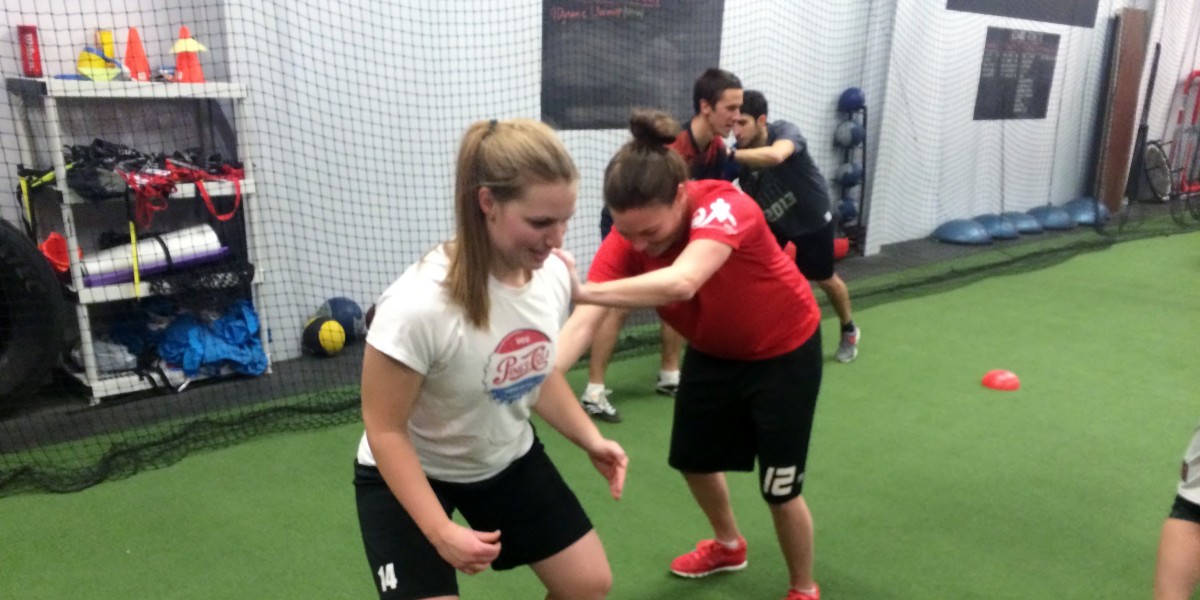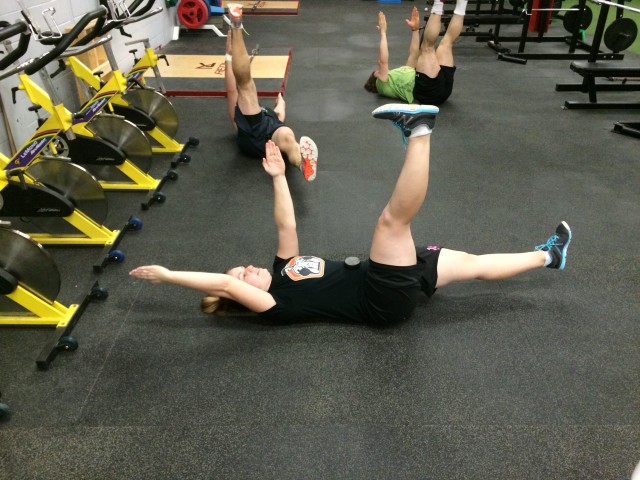 Darcy Drummond, Ultimate Canada's Female Athlete of the Year in 2014, helps Bri VanderGriendt test her kinetic chain's stability
Darcy Drummond, Ultimate Canada's Female Athlete of the Year in 2014, helps Bri VanderGriendt test her kinetic chain's stability
Part one of the stability series introduced the gluteal muscles as the mover and shaker of athletic performance, while part two provided a few exercises designed to make sure your booty is as stable and powerful as possible. I hope that you have built yourself some buns of steel with glute bridges, monster walks, and pigeon stretches. If you have not spent some time with the first two installments, I highly recommend going back and delving into the wonderful world of gluteal stability. Your moneymaker will thank you.
Now that you are well on your way to being a posterior-chain-dominant powerhouse, it is time to ensure that the extra force generated by your improved derriere is optimized for athletic performance and injury prevention. Dynamic displays of athleticism, such as sprinting, jumping, and throwing, require athletes to transfer the force generated from their foot making contact with ground either back into their own bodies or into an external object, like a disc. To do this, our bodies utilize our kinetic chains – the layers of muscles and tendons that support bones and ligaments – to ensure we move as fluidly as possible [Ellenbecker, 2001]. The more power one generates, the greater the demand placed on the kinetic chain [McGill, 2007].
When the kinetic chain is weak, movement becomes inefficient and potentially dangerous. Due to a variety of factors, such as faulty training protocols and sitting for extended periods, most athletes’ kinetic chains are weakest in the midsection. This area is colloquially referred to as “the core” and is commonly associated with crunches, dieting, and hawt abz. In reality, the term “core” refers to the lumbopelvic hip complex, which is composed of the lumbar vertebrae, the pelvis, and the hip joint [Wildon, 2005]. For simplicity’s sake, I will refer to the midsection of the kinetic chain as the trunk. Despite what fitness magazines and online pop-ups tell you, training the trunk requires a series of progressive isometric holds, not a variety of crunches and sit-ups.
Much like underdeveloped gluteal muscles, a weak trunk brings forth a host of potential injury concerns. Most alarming is the stress a poor trunk places on the spine. An unstable trunk leaves the spine unprotected [Panjabi, 1992b] from the forces generated by sprinting and the rotational demands of throwing. Made up of a plethora of muscles, including the transverse abdominis, internal oblique, external oblique, and spinal erectors, as well as intersegmental stabilizers such as the multifidus muscles, the trunk is complex and a hotly debated topic. Fortunately, the training protocol for it is simple: stability, stability, stability.
The key to improving athletic performance and reducing injury in relation to the trunk is learning how to breathe while simultaneously tightening the muscles surrounding the midsection. In other words, trunk training is the ultimate expression of stability. To accomplish this task, athletes should employ a series of isometric holds. Isometric holds, such as planks, uniformly build up the muscles of the mid-section and avoid imbalances, which may reduce the effectiveness of the kinetic chain [Lique-Suarez, 2012].
While strength is important, endurance is also a factor in both injury prevention and performance optimization. When trunk musculature is fatigued, athletes find themselves in non-athletic positions typically associated with injury [Sommer, 1998]. I notice this most during long points on Sundays. Athletes who started the tournament weekend with a spring in their step end up rounded over trying to survive marathon points. Training your trunk requires a dedicated, results-based approach designed to improve muscular endurance [Bilven, 2013] and address the multi-planar demands of ultimate while progressively increasing in difficulty [Akuthota, 2003].
There are a host of trunk training protocols on the internet and I have selected some of my favorites. Researcher Stu McGill recommends the big three: the side bridge, the bird dog, and the curl up [McGill 2007]. Similarly, movements such as the GHD Bridge provide a barometer for measuring progress, as well as an interesting and difficult test, while deadbug progressions teach how to simultaneously breath and brace your trunk. Pillar variants challenge trunk stability. Here are some of my favorite progressions:
- Consider these test movements.
- Perform a GHD bridge on a Glute Ham Developer or with a training partner you trust (see video).
- Maintain a neutral position as long as possible by contracting gluteal muscles, trunk muscles, and every other muscle that comes to mind.
- The GHD Bridge is significantly easier than the GHD Supine.
- Arm positioning will increase or decrease the level of difficulty. For an interesting test, attempt a GHD Supine with your hands over your head holding a light object.
- Begin by lying on the floor and attempting to drive your ribcage into the ground.
- At the same time, expand your belly by taking a breath in. Think of your stomach as a crumpled-up pop can.
- Tighten your core musculature and establish a neutral spine position.
- Raise yours hands and legs simultaneously to 90 degrees of flexion. Do not let your legs come up too far, and ensure your tailbone remains on the ground.
- Attempt to accumulate two minutes in a position. Once basic competence is acquired, attempt more advanced versions of the movement.
- In this variation the legs remain bent allowing an athlete to compensate for poor mobility
- In this variation the legs are straight. Ensure your tailbone remains on the ground.
Ipsilateral Straight Leg Deadbug and Contralateral Straight Leg Deadbug
- Once you have mastered the straight leg variation of the Deadbug, these options allow for continued progress.
- Slowly raise and lower your limbs as indicated in the videos while focusing on maintaining your breath.
- Begin the pillar by contracting the abdominal musculature to create a stable neutral spine position.
- Raise from a prone position on the ground to a support position on your elbows and toes.
- Maintain a neutral spine while squeezing the gluteal muscles.
- Ensure you are not rounding at the upper back or sagging at the lower back.
- Build towards 2 minutes of competency.
- In this variation, you hold a static position and focus on maintaining a neutral spine.
- From a static pillar, reach slowly out in front of you and attempt to maintain a neutral spine.
- Maintain gluteal engagement and attempt to avoid shifting from side to side.
- Slowly raise one arm forward before adducting the arm 90 degrees, then pause before bringing the arm to your side. Repeat on the opposite side.
- While maintaining a neutral spine, raise up on the feet and downside elbow.
- Keep your body as straight as possible, ensuring the ankle, hip, and shoulder joints remain aligned.
- Squeeze your gluteal musculature in order to maintain a stable position.
- Perform a side pillar and slowly raise and lower your hip as shown in the video.
- This position is performed while maintaining a neutral spine.
- Begin from a side pillar before reaching in front and under the body.
- Return to the start position.
Trunk stability is integral to field performance. Without it, athletic endeavours may become ineffective at best and dangerous at worst. Hopefully these isometric holds have provided a solid starting point for tuning up your tummy. Focus on taking your time and performing each progression as perfectly as possible. There is no reason to attempt an anchored leg lower deadbug unless you have mastered the quadrilateral straight leg variant. Trunk stability comes from the development of the mid-line through a systematic approach. Try some of these exercises out and let me know how it goes in the comments. The next installments will look at strengthening the shoulder girdle.










Comments Policy: At Skyd, we value all legitimate contributions to the discussion of ultimate. However, please ensure your input is respectful. Hateful, slanderous, or disrespectful comments will be deleted. For grammatical, factual, and typographic errors, instead of leaving a comment, please e-mail our editors directly at editors [at] skydmagazine.com.